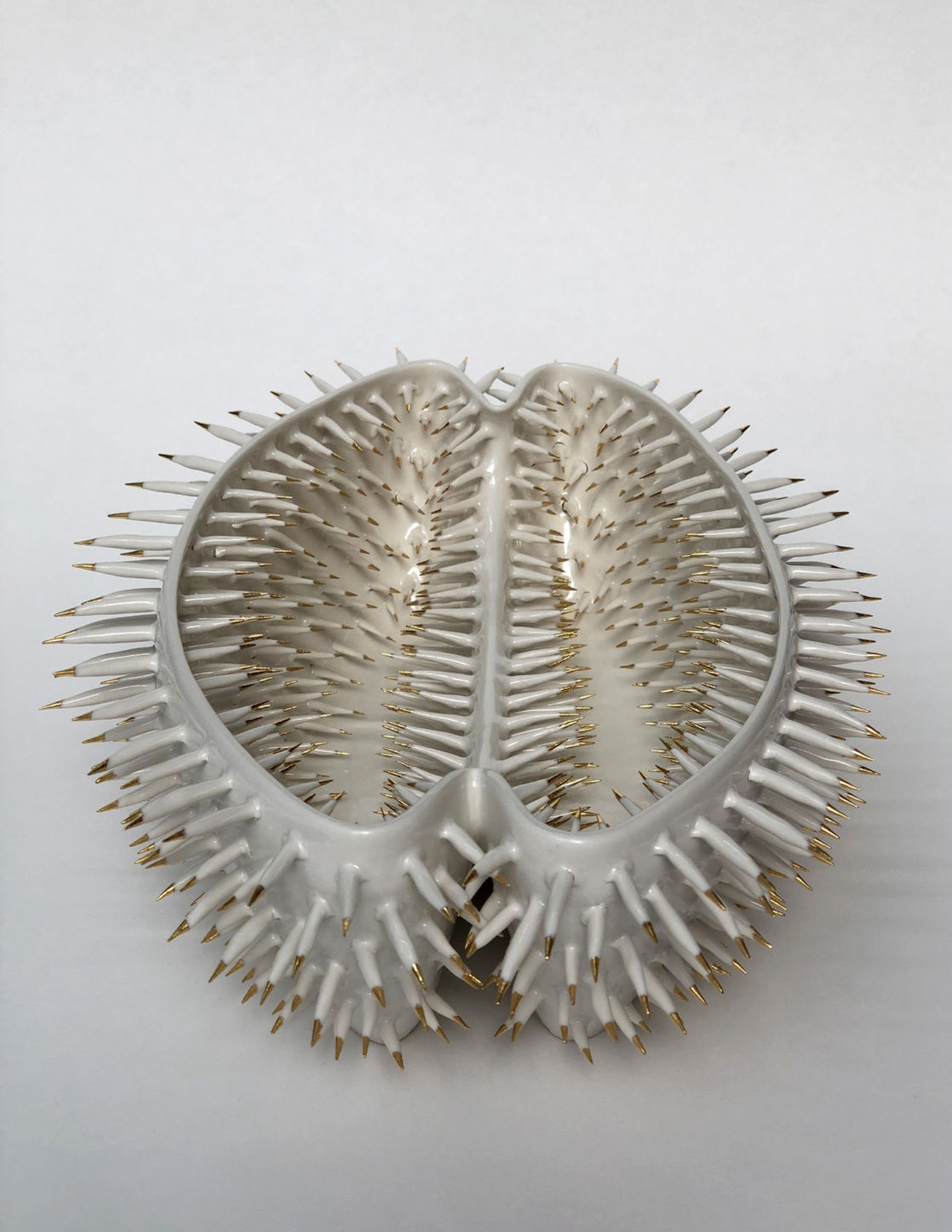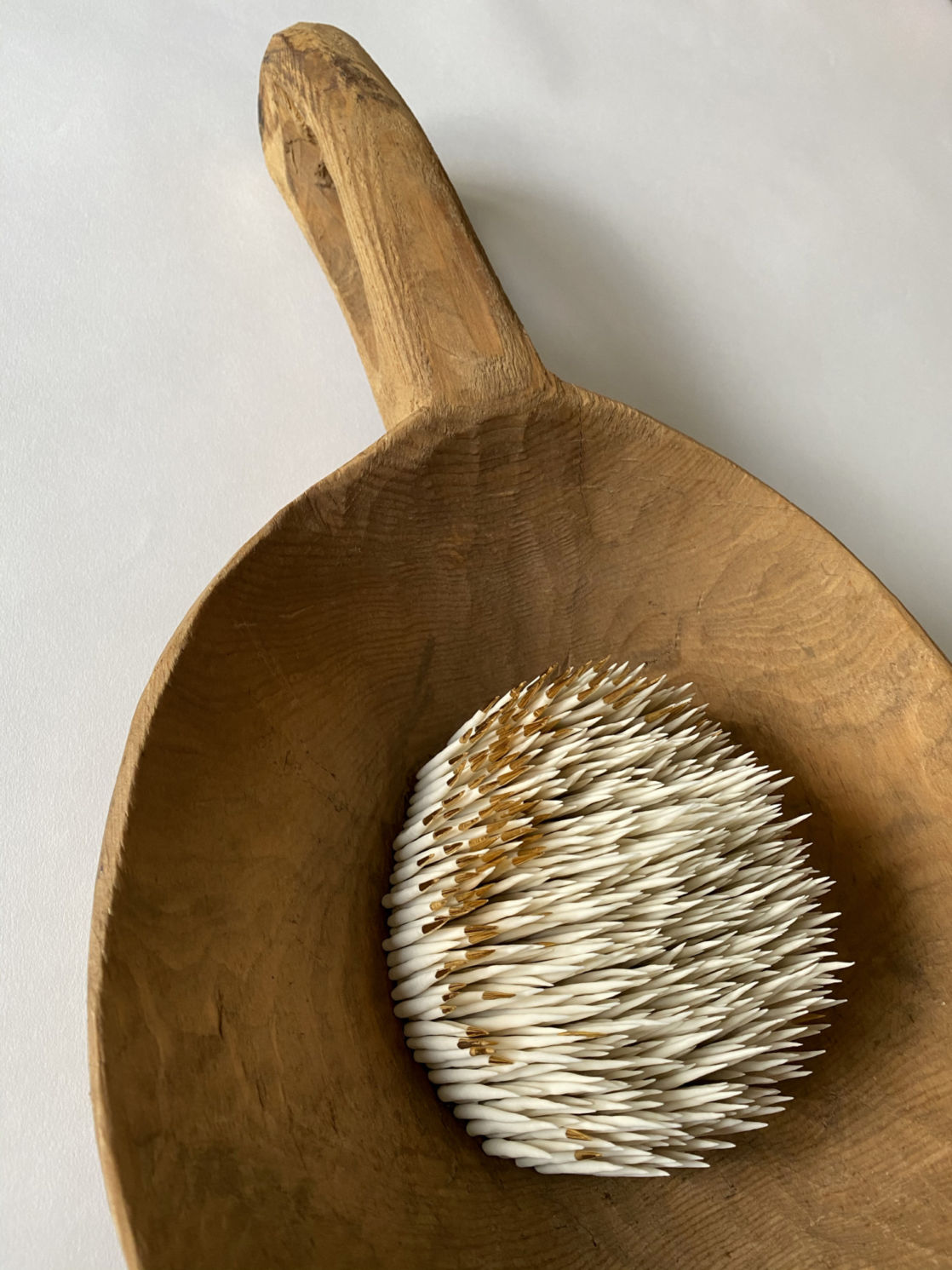Welcome to Ceramic Review
Ceramic Review is the magazine for contemporary and historical ceramics, ceramic art and pottery.
Ceramic Review Issue 326
March/April 2024
Ceramic Review is the magazine for contemporary and historical ceramics, ceramic art and pottery.
March/April 2024
Ceramic artist Ikuko Iwamoto has been experimenting in porcelain since training under a ceramic master in Japan. Jane Audas discovers more about her practice, which encompasses both tableware and abstract sculptural works

Ikuko Iwamoto spends a lot of time in her small, compact and organised studio at the Chocolate Factory in North London. She has recently invited us all to squeeze in there with her too, via her new YouTube channel: Ikuko 100. She usually aims to be in her studio between four and five hours each day, between dropping off and picking up her children. Iwamoto works in a highly intensive manner, making slip-cast porcelain tableware and more experimental framed artworks. She likes to work listening to YouTube videos about history or news. So it seemed like the right platform when it came to getting her own work out there. Iwamoto began posting videos on 6 October 2018, to launch her project making 100 slip-cast vases over four years. Her channel has other videos, including (at the time of writing) several about making teapots. Her husband Kazu Kondo films them and they edit the videos together. The videos are longer than usual but are easy to watch. In the very first one – which sets the scene for the series – Iwamoto plays us in on her Jew’s harp and is wearing fabulous patterned overalls.
CERAMIC TRAINING
None of the craftsmanship of Iwamoto’s work is diluted by YouTube however, in fact it makes one marvel at just how detailed and exacting her process is.
Slip-casting is not for the faint-hearted or impatient. Iwamoto first came across the technique when she was at the Royal College of Art. She had come to London to study in 2001, after a decade (and more) of studying, teaching and working as a ceramist in Japan. There she had hand-thrown and hand built all of her ceramics. Her ceramic master, when she enrolled on the BA Crafts Ceramic History at Tezukayama College, Japan, in 1990, was Asuka Tsuboi, an influential ceramist. Tsuboi, based in Kyoto, had been one of the pioneering women potters to emerge in Japan in the 1970s, challenging the incipient misogyny of women having been forbidden to train in ceramic studios. After graduating in 1993, Iwamoto continued to assist Tsuboi, ‘she as the master, I as the student,’ she says. She also taught ceramics at Tezukayama College and adult ceramic classes in Osaka. Until, in 2001, she came to London, encouraged by Tsuboi, ‘without her recommendation I wouldn’t have been able to come here and study at Camberwell College of Arts,’ Iwamoto explains. She found studying in England completely different, requiring a more thoughtful approach, particularly toward her own practice: ‘When I was in Japan and free to make anything,


I didn’t think much about the ideas and philosophy behind my work, I was focused on the technique. At Camberwell, before I started making I had to think about concepts and background storytelling. I had to focus on what I was going to make and then present it. Technically my work wasn’t much different, as I was still handbuilding large sculptural pieces, but my relationship with the tutors and other students was completely different. We had to share and take advice.’
DEVELOPING TECHNIQUES
As she skipped the first year at Camberwell, after two years, Iwamoto applied to the Royal College of Art (RCA), but struggled during her first year there. ‘I was wondering how I could develop my work, which way I was going to go,’ she explains. ‘I had always wanted to use porcelain as a material. I had never used it in Japan, I hadn’t been allowed to because it was so precious.’
Handbuilding porcelain proved difficult, so she decided to try slip-casting. It was a completely new material and a completely new technique. ‘It was a big challenge,’ she adds. ‘Hand-throwing was much more fun. I had to concentrate when making moulds. It was stressful, but I have always liked a new challenge.’
After graduating from the RCA in 2006, Iwamoto was still making functional tableware. Sculptural, yes, but still functional: ‘a kind of product to sell.’ Then in 2012, she made her first framed artwork. ‘My background was making handbuilt sculptures and I wanted to go back to that. But making freestanding sculptures with porcelain was difficult. I wanted to make framed pieces,’ she says. For both her tableware and her artworks, Iwamoto meticulously draws out each piece before she makes it. Her drawings for the framed pieces look rather like technical drawings. She sometimes combines found man-made objects in amongst her porcelain pieces: ‘To make a sort of installation, a drawing or painting in a frame.’ Her framed works have an abstract quality but also nod toward the microscopic world, which inspires her. When she was a student in Japan, she had a friend who was studying science and became interested in biological processes. She wrote her dissertation at the RCA on the subject of self-taught outsider artists in Japan, meeting the curator and professor Tadashi Hattori, author of a book on the subject. She found the use of repetition in outsider art intriguing; something perhaps echoed in her ubiquitous, trademark decorations: spikes, spots and dots. Iwamoto also cites the artists Paul Klee, Victor Pasmore and Yayoi Kusama amongst her inspirations.

FINDING BALANCE
Despite using slip-casting, Iwamoto usually only makes one of each of her bigger framed works and limited editions of the smaller ones. She makes more use of moulds for her tableware. But really, for Iwamoto, slip-casting porcelain (she uses Valentine Clay’s special porcelain slip from Stoke-on-Trent) is a means to an unusual shape, rather than an opportunity to mass-produce anything. She is using it in a fine art way to make sometimes just one unusual shape, or a structure that she couldn’t get from handbuilding: ‘My first goal is making the shape I really want to show, that is my first priority,’ she explains. And it is her love of form that keeps her colour palette minimal, too. ‘I don’t normally use colour because I love the structure and I like the fact that the shadows (of the spikes) can affect the colour of the piece.’
Iwamoto acknowledges there is a difference between making tableware and her framed artworks. ‘When I make tableware, it’s like a direct communication between the people who purchase my work and me. I’m thinking about how people will use it,’ she says. ‘When making the framed sculptures I’m free, I can put anything I want in the box.’


She tries to strike a balance between making functional pieces, which many collectors want to buy from her, and making her framed artworks, which obviously satisfy her artistic muse. But even her plainer tableware is pushed to surprise – as spikes give bite to otherwise quite simple shapes. ‘Disturbing is perhaps my unique selling point. Lots of people don’t like my spikes and dots,’ she explains. It is that ability to make us look twice at a piece that sets Iwamoto’s work apart. If she needed a strap line for her practice, it might be: expect the unexpected.
For more details visit ikuko.space.